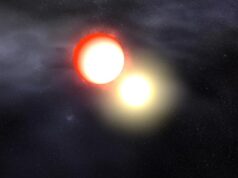Peeking out of the South Pacific Ocean are two little islands, their dark rock contrasting sharply with the azure water lapping at their edges. While seemingly unremarkable, they are all that is now visible of a huge underwater volcano. The islands are in fact small peaks on the rim of alarge cauldron-like hollow that lies at the heart of Hunga Tonga-Hunga Ha’apai.
The volcano exploded violently in January 2022, blasting 10 cubic km (2.4 cubic miles) of rock, ash and sediment straight up into the sky, producing a plume 36 miles (58km) high. It was the biggest atmospheric explosion to be recorded by modern instruments. The enormous volcanic cloud blanketed the region and was so big it could be seen by astronauts orbiting onboard the International Space Station. A megatsunami with waves up to 45m (147ft) high were hurled outwards by the eruption, devastating the islands of Tonga and causing damage as far away as Russia, Hawaii, Peru and Chile. At least six people lost their lives in the tsunami, according to reports, including two in Peru. (Learn more about the damage caused by the tsunami.)
But the explosion and tsunami were not the only record-breaking events triggered by the volcano’s eruption. It also sparked the most intense lighting storm ever witnessed.
“This is an eruption of superlatives,” says Alexa Van Eaton, a volcanologist at the United States Geological Survey who led a study of the extraordinary electrical activity inside the ash cloud produced by Hunga Tonga-Hunga Ha’apai. The supercharged thunderstorm was monitored from space by satellites, offering an unparalleled view of the high-altitude lightning strikes inside the volcanic plume. And the fury of the lightning – “the likes of which we’ve never seen”, says Van Eaton – is also offering new and valuable insights into the volcano itself and what took place during the eruption. (Learn more about the power of the record-breaking eruption.)
A record-breaking thunderstorm
At its peak, the thunderstorm triggered by the volcanic plume above Hunga Tonga-Hunga Ha’apai produced 2,600 flashes of lightning every minute. Nearly 200,000 flashes of lightning lit up the inside of the dark ash cloud for 11 hours. Bright bursts of electrical discharge rose 12-19 miles (20-30km) above the ocean, which is almost three times as high as a cruising Boeing 747 passenger airliner – some of the highest-altitude lightning flashes ever recorded.
The plume produced by the Hunga Tonga-Hunga Ha’apai volcanic eruption spread over a vast area once it reached the upper layers of the atmosphere (Credit: Nasa)
“Having lightning well into the stratosphere is highly unusual,” says Van Eaton.
Volcanic lightning is not uncommon. It was arguably first recorded by the Ancient Roman lawyer and writer Pliny the Younger in a letter to a friend. He described “zigzag flashes” that accompanied the eruption of Mount Vesuvius, which destroyed Pompeii in AD 79.
But the sheer amount of lightning generated by the Hunga volcano has surprised volcanologists. “It’s more than we’ve seen anywhere on the planet, including supercells,” says Peter Rowley, a physical volcanologist at the University of Bristol, UK. Supercells are a severe form of thunderstorm that bring intense lightning flashes, extreme rainfall and even heavy hail. By comparison, however, these have been seen to produce dozens of lightning flashes per minute.
The lightning storm in the volcanic plume of Hunga Tonga-Hunga Ha’apai was so intense that ground-based radio antennas thousands of kilometres away picked up the activity.
Researchers think the storm developed because the highly energetic expulsion of magma blasted through the shallow ocean. Molten rock vaporised the seawater, which rose up into the plume of ash and debris. More than 146 million tonnes (161 million tons) of water vapour were thrown into the Earth’s stratosphere by the eruption – adding an extra 10% to the amount of water found in the stratosphere in just a few days. Nasa later reported that the volume of water was enough to fill the equivalent of 58,000 Olympic-size swimming pools. The water vapour even reached into the mesosphere – one of the upper layers of the atmosphere.
The interaction between the volcanic ash, water molecules and particles of ice in the plume – which formed as water droplets were supercooled in the high atmosphere – built up large electrical charges, producing the perfect conditions for lightning. (Learn more about how the plume reached half-way to space.)
“It turns out, volcanic eruptions can create more extreme lightning than any other kind of storm on Earth,” says Van Eaton.
But it was not just the intensity of the lightning that intrigued Van Eaton and her colleagues.
Concentric rings of lightning, centred on the volcano, expanded and contracted in the plume over time. “The scale of these lightning rings blew our minds,” she says. “We’ve never seen anything like that before, there’s nothing comparable in meteorological storms. Single lightning rings have been observed, but not multiples, and they’re tiny by comparison.”
The researchers believe that it was the intense, high-altitude turbulence created by the volcanic blast that was responsible. The vast amount of material blasted upwards by the volcanic eruption rapidly rose to its maximum height and expanded outward to create an umbrella-shaped cloud more than 186 miles (300km) wide. The momentum generated by the blast caused the material in the plume to continually “overshoot” into the stratosphere, generating fast-moving concentric ripples known as gravity waves, a little like dropping pebbles in a pond. The lightning appeared to “surf” these waves and expanded outward, in a pattern of 155 mile-wide (250km) rings.
“Seeing that the lightning rings were formed by, or at least associated with gravity waves moving through the cloud was really impressive to us,” says Van Eaton.
It was the first time that data has demonstrated how a powerful volcanic plume can create its own weather system, sustaining the conditions for electrical activity at heights and rates not previously observed.
“It’s possible that in very big eruptions, these kinds of concentric growing rings – these gravity waves of ash- are followed by lightning, maybe more than we think,” says Rowley, who was not involved in Van Eaton’s study. But he says more data is needed to be sure.
The lightning also offered more than just an impressive light show – it helped to reveal new details about the Hunga Tonga-Hunga Ha’apai eruption and its timeline.
You might also be interested in:
Data gathered on the lightning from a combination of satellite images and data from ground-based radio antenna, showed the volcano’s behaviour could be defined in four distinct phases of activity. The lightning rates waxed and waned as the plume height changed.
It started with a very small plume, “so puny that no one had paid any attention to it”, explains Van Eaton. Then, in phase two, the plume began to rise from a much higher intensity eruption for several hours, ejecting a huge amount of rock, ash and sediment into the air – equivalent to the amount of rock need to build the Great Pyramid of Giza 3,800 times over.
Phase three saw the eruption continue at a lower intensity, with the plume height dropping to around 12-19 miles (20- 30km) high. “That’s still extraordinary,” says Van Eaton. Then there was an intriguing pause as the volcano seemingly took a break, she explains before phase four saw the eruption decreasing in ferocity over time.
“Being able to tease out this final gasp of the climactic phase is really helpful for those who need to forecast the ash emissions and transport through the atmosphere,” says Van Eaton.
In the days that followed the eruption, the enormous ash cloud produced by Hunga Tonga-Hunga Ha’apai was swept by winds to nearly 1,860 miles (3,000km) west to Australia. The ash can affect water supplies where it falls and hamper aid efforts.
Disruption due to volcanic ash is also extremely costly to airlines. For example, in 2010 the eruption of Icelandic volcano Eyjafjallajökull cost the aviation industry an estimated £1.1 billion (US$1.4bn).
It is currently difficult to get reliable information about volcanic plumes at the beginning of an eruption, especially for remote, submarine volcanoes. But the data from Hunga Tonga-Hunga Ha’apai could help meteorologists to monitor and “nowcast” aviation-related hazards from explosive volcanism, including ash cloud development and movement.
Understanding this is vital, as scientists say an eruption the scale of Hunga Tonga-Hunga Ha’apai will likely happen again. And the threat is galvanising collaboration among researchers.
David Tappin, an expert on tsunamis triggered by volcanoes at the British Geological Survey Keyworth and a former chief geologist for the Kingdom of Tonga, warns that the unexpected nature of the Hunga Tonga-Hunga Ha’apai eruption highlights that the global hazard from large-volume volcanic eruptions is underestimated.
There are approximately 42 volcanoes around the world with the potential to erupt as spectacularly as Hunga Tonga-Hunga Ha’apai, says Tappin. This record-breaking eruption should serve as a wake-up call to prepare for more, but we are largely unprepared for the effects of these events, he says.
“This eruption has had such global and wide-ranging impacts that we’re all starting to reorganise the way we talk to each other,” adds Van Eaton. There were weeks of lower-level plumes before Hunga Tonga-Hunga Ha’apai “went berserk”, she says. “It goes to show you that even a fairly standard eruption can change tack at any time, and there’s really not an easy way to forecast that or predict that.”
—
Join one million Future fans by liking us on Facebook, or follow us on Twitter or Instagram.
If you liked this story, sign up for the weekly bbc.com features newsletter, called “The Essential List” – a handpicked selection of stories from BBC Future, Culture, Worklife, Travel and Reel delivered to your inbox every Friday.









